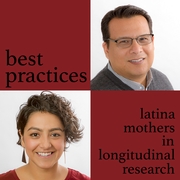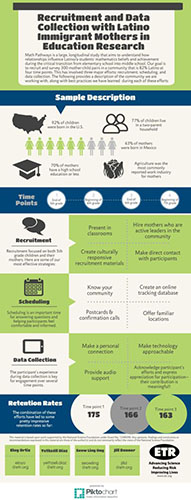Best Practices: Keeping Latina Mothers Involved in Longitudinal Research
By Eloy Ortiz, MURP, & Yethzéll Díaz | August 25, 2015
Research Associate & Research Assistant, ETR
Math Pathways is a longitudinal study that aims to understand how relationships influence Latino students’ mathematics beliefs and achievement during the critical transition from elementary to middle school. Our goal was to recruit and survey 300 mother-child pairs from a rural, predominantly Latino farming community at four different time points over 18 months. Over the process of designing, implementing and refining our recruitment and retention efforts, we have established best-practice standards that have contributed substantially to our retention success.
This study is a part of a larger, applied research effort that aims to give voice to underserved populations, while collecting data that can be used to create programs and opportunities for them to improve their lives. One of the goals is to develop and implement culturally responsive research methods.
Gathering the data for this research study has involved three major efforts: recruitment, scheduling and data collection. Our infographic, “Recruitment and Data Collection with Latino Immigrant Mothers in Education Research,” provides a snapshot of our participants, along with the best practices we have developed to reach our goals. Here, we highlight a few of the practices that have stood out during the implementation of the project.
Recruitment
Recruitment focused on reaching out to both 5th grade children and their mothers. In our partner community, many of the mothers work in the agricultural industry, where season-dependent, 6-day work weeks and 10-hour days are often the norm (we wrote about these families in an earlier post).
These families place a high value on hard work and education, so the mothers were highly motivated by the fact that the information they provided would be used to improve programs around the community. In order to get the word out about the study, we focused on how the findings could benefit their children’s education. To this end, we gave presentations at school and community events. We created culturally responsive flyers in both Spanish and English that included bright, colorful images which stood out from most other material children receive at school. We also offered gift cards as more immediate benefits.
Scheduling
Many of the mothers who signed up for the study did not talk directly with the research team until they received a phone call to schedule a time to do the survey. These calls provided an opportunity to answer questions, address concerns and help participants feel comfortable and informed about the study. Each mother was assigned a dedicated caller, to ensure consistency in whom they talked to. Over 600 survey appointments have been scheduled so far. We learned that the best times to call are late in the evening, and that text messages are often preferred.
Data Collection
The mother’s experience during data collection influences her willingness to participate throughout the study. In order to provide a familiar experience, our team included trained researchers, as well as bilingual, bicultural mothers who were able to make personal connections through their shared experience raising children in the same community.
We used several strategies to ensure that mothers felt comfortable and acknowledged on the day of the survey. For example, we met the mothers at a location that was familiar to them, such as a public library or their child’s school. We also made it a point to acknowledge and express our appreciation for the mothers’ willingness to take time out of their busy lives to participate in this study.
Each mother was given an orientation and offered audio support to complete the survey on a tablet computer. We also created a welcome space for children, including tablet computers on which they could play games.
Finally, we gave participants time and space to ask questions, and promised to keep them up to date on what they can expect next. This effort has led to an outstanding retention rate so far: 95% completed a second survey, and 93% completed a third survey.
We will update our best practices as we complete this project, and hope to have more information about longitudinal survey retention with Latino participants in the near future.
Eloy Ortiz, MURP, is a Research Associate at ETR. He has been the research coordinator for multiple projects focused on increasing the computer-science educational attainment of Latino/a youth in Santa Cruz County. He can be reached at eloyo@etr.org.
Yethzéll Díaz is a Research Assistant at ETR. Contact her at yethzell.diaz@etr.org to learn more about the Math Pathways project or discuss this column.
This research is supported by a grant from the National Science Foundation (1248598) to Jill Denner and Brett Laursen.






